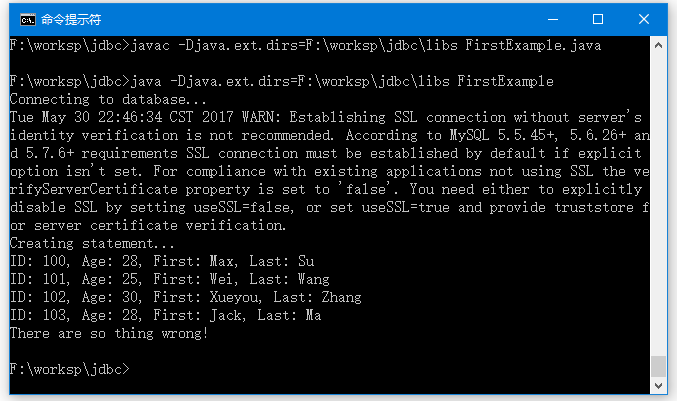JDBC Statements範例
2019-10-16 22:13:23
在建立Statement物件後,可以使用它來執行一個SQL語句,它有三個執行方法可以執行。它們分別是 -
boolean execute (String SQL): 如果可以檢索到ResultSet物件,則返回一個布林值true; 否則返回false。使用此方法執行SQLDDL語句或需要使用真正的動態SQL,可使用於執行建立資料庫,建立表的SQL語句等等。int executeUpdate (String SQL):返回受SQL語句執行影響的行數。使用此方法執行預期會影響多行的SQL語句,例如:INSERT,UPDATE或DELETE語句。ResultSet executeQuery(String SQL):返回一個ResultSet物件。 當您希望獲得結果集時,請使用此方法,就像使用SELECT語句一樣。
此範例程式碼是基於前面章節中完成的環境和資料庫設定編寫的。
複製以下程式碼儲存到JDBCStatement.java檔案中,編譯並執行如下 -
//STEP 1. Import required packages
// package com.yiibai
import java.sql.*;
public class JDBCStatment {
// JDBC driver name and database URL
static final String JDBC_DRIVER = "com.mysql.jdbc.Driver";
static final String DB_URL = "jdbc:mysql://localhost/EMP";
// Database credentials
static final String USER = "root";
static final String PASS = "123456";
public static void main(String[] args) {
Connection conn = null;
Statement stmt = null;
try{
//STEP 2: Register JDBC driver
Class.forName("com.mysql.jdbc.Driver");
//STEP 3: Open a connection
System.out.println("Connecting to database...");
conn = DriverManager.getConnection(DB_URL,USER,PASS);
//STEP 4: Execute a query
System.out.println("Creating statement...");
stmt = conn.createStatement();
String sql = "UPDATE Employees set age=30 WHERE id=103";
// Let us check if it returns a true Result Set or not.
Boolean ret = stmt.execute(sql);
System.out.println("Return value is : " + ret.toString() );
// Let us update age of the record with ID = 103;
int rows = stmt.executeUpdate(sql);
System.out.println("Rows impacted : " + rows );
// Let us select all the records and display them.
sql = "SELECT id, first, last, age FROM Employees";
ResultSet rs = stmt.executeQuery(sql);
//STEP 5: Extract data from result set
while(rs.next()){
//Retrieve by column name
int id = rs.getInt("id");
int age = rs.getInt("age");
String first = rs.getString("first");
String last = rs.getString("last");
//Display values
System.out.print("ID: " + id);
System.out.print(", Age: " + age);
System.out.print(", First: " + first);
System.out.println(", Last: " + last);
}
//STEP 6: Clean-up environment
rs.close();
stmt.close();
conn.close();
}catch(SQLException se){
//Handle errors for JDBC
se.printStackTrace();
}catch(Exception e){
//Handle errors for Class.forName
e.printStackTrace();
}finally{
//finally block used to close resources
try{
if(stmt!=null)
stmt.close();
}catch(SQLException se2){
}// nothing we can do
try{
if(conn!=null)
conn.close();
}catch(SQLException se){
se.printStackTrace();
}//end finally try
}//end try
System.out.println("There are something wrong!");
}//end main
}//end JDBCStatment
現在編譯上面的例子如下 -
## 編譯 Java 程式碼
F:\worksp\jdbc>javac -Djava.ext.dirs=F:\worksp\jdbc\libs JDBCStatment.java
## 執行 Java 程式碼
F:\worksp\jdbc>java -Djava.ext.dirs=F:\worksp\jdbc\libs JDBCStatment
執行JDBCStatement時,應該會看到輸出以下結果 -
